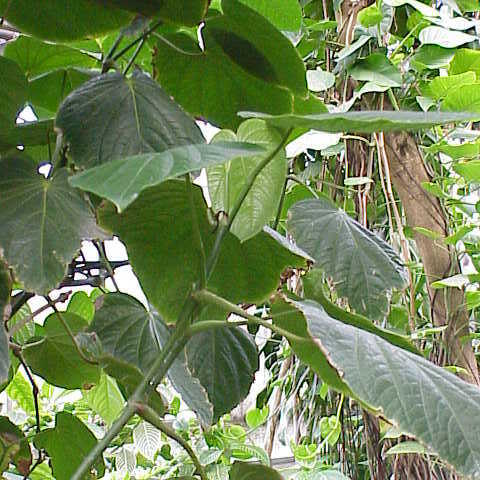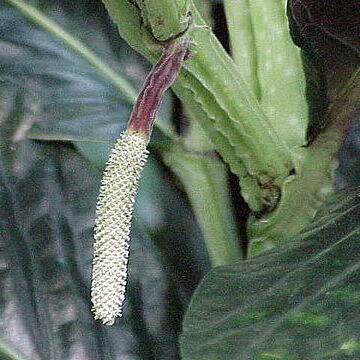Herbs, subshrubs, shrubs or treelets, sometimes with scrambling branches, rarely climbers or lianas. Stems usually with swollen nodes. Prophyll (a bract-like structure) present at base of axillary shoot-apex in flowering branches, minute or well developed, soon caducous; another bract-like sheathing structure is present in some species (e.g. P. hispidum). Leaves alternate; petioles often vaginate or winged, at base only or to apex (base of leaf blade), their margins may extend beyond base of blade; blades basely attached or peltate, symmetrical or asymmetrical, at base often quite some difference in attachment of blade to petiole (measures are given where this occurs), glabrous or variously pubescent, often glandular-dotted, sometimes scabrous; palmately or pinnately veined. Inflorescences simple, pedunculate spikes, solitary, leaf-opposed (in P. peltatum axillary on reduced, leafless branches, umbel-like); floral bracts peltate, rounded, triangular or cucullate, subtending reduced flowers. Flowers bisexual (in P. hymenophyllum protandrous, functionally unisexual); stamens 1-6, filaments short (long exserted in P. hymenophyllum); ovary sessile or occasionally on a short stipe, stigmas (2-)3-4, sessile or on a style. Fruits drupes, embedded in rachis to exserted, separate from each other or in compact rows, glabrous or with indument, globose or variously shaped due to compression, stigmas persistent.
Herbs, subshrubs, shrubs or treelets, sometimes with scrambling branches, rarely climbers or lianas. Stems usually with swollen nodes. Prophyll (a bract-like structure) present at base of axillary shoot-apex in flowering branches, minute or well developed, soon caducous; another bract-like sheathing structure is present in some species (e.g. P. hispidum). Leaves alternate; petioles often vaginate or winged, at base only or to apex (base of leaf blade), their margins may extend beyond base of blade; blades basely attached or peltate, symmetrical or asymmetrical, at base often quite some difference in attachment of blade to petiole (measures are given where this occurs), glabrous or variously pubescent, often glandular-dotted, sometimes scabrous; palmately or pinnately veined. Inflorescences simple, pedunculate spikes, solitary, leaf-opposed (in P. peltatum axillary on reduced, leafless branches, umbel-like); floral bracts peltate, rounded, triangular or cucullate, subtending reduced flowers. Flowers bisexual (in P. hymenophyllum protandrous, functionally unisexual); stamens 1-6, filaments short (long exserted in P. hymenophyllum); ovary sessile or occasionally on a short stipe, stigmas (2-)3-4, sessile or on a style. Fruits drupes, embedded in rachis to exserted, separate from each other or in compact rows, glabrous or with indument, globose or variously shaped due to compression, stigmas persistent.
Herbs, shrubs, slender trees, climbers or scramblers, only rarely epiphytic, if with unisexual flowers (usually in the Old World) then monoecious or dioecious; stemsthickened at the nodes, often hollow, sometimes producing adventitious roots, glabrous or with indumentum of simple or multicellular hairs. Leaves alternate, petiolate, symmetrical or asymmetrical, occasionally peltate, sometimes lobed at the base, membranous to coriaceous; venation palmate or pinnate; petiole sometimes sheathing, the adnate stipule-like organs soon falling. Inflorescences leaf-opposed or apparently axillary, pedunculate, solitary or in one small but very widespread group several on short leafless shoots. Flowers hermaphrodite (mostly New World) or unisexual, sessile or pedicellate, crowded to widely placed on an often fleshy rhachis, each with a round triangular semilunate or calceiform bract. Stamens 2–6; anthers basifixed with thecae usually distinct. Ovary conoid, subglobose, conic, obovoid or subcylindrical; styles long, short or absent; stigmas 2–4. Fruits globose, obpyramidal, cylindrical or ovoid to flask-shaped, dry or fleshy, glabrous to densely puberulous, papillose-pubescent or hispidulous, sometimes glandular, often pedicellate.
Shrubs or climbers, rarely herbs or small trees, aromatic. Stems thickened at nodes; outer vascular bundles in a ring, inner bundles scattered in 1 or 2 series. Prophylls present, often ± connate to petiole, caducous, forming a prominent, ringlike stipular scar at each node; main lateral veins all basal or partly pinnate. Flowers mostly unisexual, dioecious, less often monoecious or bisexual, sessile. Inflorescences leaf-opposed or rarely terminal spikes, rarely spikes grouped in an apparently axillary umbel; bracts small, sometimes adnate to rachis, often peltate. Stamens 2-6, usually on rachis, rarely at base of ovary; anthers 2-loculed, 2-4-lobed. Ovary distinct or sometimes immersed in rachis; ovule 1; stigmas (2 or)3-5. Fruit a drupe, sessile or stalked, often red or yellow, obovoid, ovoid, globose, or obovoid to cuneate-obovoid and laterally compressed, rarely ellipsoid, usually glabrous.
Shrubs, or vines climbing by adventitious roots, occasionally epiphytic, monoecious, dioecious or bisexual. Indumentum present or absent; hairs simple, multicellular, uniseriate. Stems thickened at nodes. Leaves alternate, variously stipulate, petiolate, entire, with a prominent midvein, secondary veins emerging variously along midvein or palmately from base. Inflorescences spicate, solitary and leaf-opposed or umbellate and axillary. Flowers sessile. Stamens 2–4. Stigmas 2–5, usually sessile or with an attenuate style. Fruit pedicellate, subsessile or sessile, free and closely packed or arranged in clusters or with seeds embedded within a fleshy compound fruit.
Small trees, shrubs, subshrubs, or rarely herbs , erect or reclining, glabrous or pubescent. Leaves alternate, pubescent. Leaf blade conspicuously pinnately veined, lateral veins ascending-arching, connected by fainter, ladderlike, tertiary veins. Spikes opposite leaves, ascending-arching, densely flowered, distally drooping. Flowers sessile, borne on surface of rachis; floral bracts fringed with whitish hairs; stamens 2[-6]; stigmas [2-]3[-4]. Fruits sessile, oblong (inversely pyramidal-3-angled in P. auritum ); beak minute.
Stamens 2–4(6) in the Flora Zambesiaca area; filaments short; anthers basifixed with the thecae usually distinct.
Inflorescences axillary or leaf-opposed, pedunculate, with flowers in dense cylindrical spikes, rarely racemose.
Ovary ± ovoid to subglobose; stigmas 2–4(5), erect or recurved, sessile or on a short style.
Leaves alternate, sometimes asymmetrical at the base, membranous or coriaceous.
Flowers hermaphrodite or unisexual; plants monoecious or dioecious.
Fruit a ± globose 1-seeded drupe, sessile, rarely pedunculate.
Seed sub-globose; testa thin; endosperm and perisperm hard.
Erect, scandent or climbing shrubs, or sometimes lianes.
Stipules adnate to the petiole, soon caducous.
Stems often hollow, jointed at the nodes.


